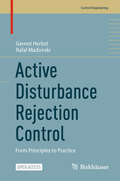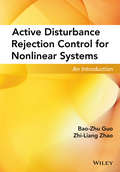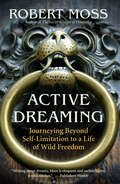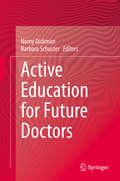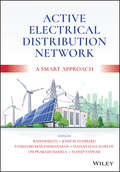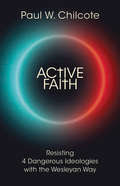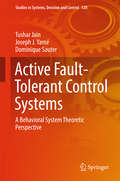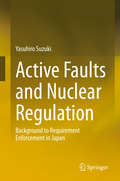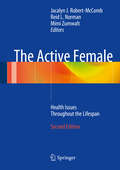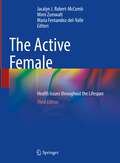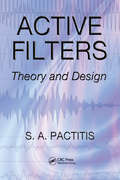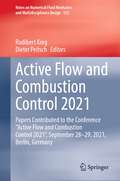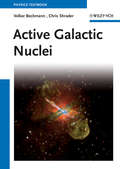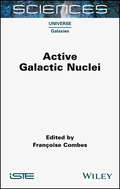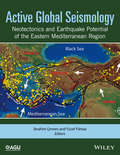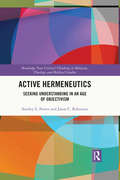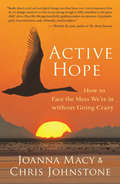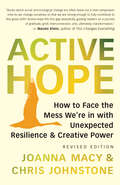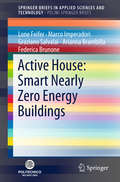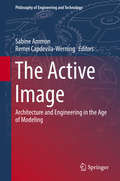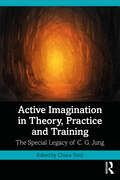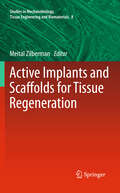- Table View
- List View
Active Disturbance Rejection Control: From Principles to Practice (Control Engineering)
by Gernot Herbst Rafal MadonskiThis open access text offers the first comprehensive introduction to the fundamental principles and practical implementation of Active Disturbance Rejection Control (ADRC). Drawing on their years of experience in both research and industry, the authors have designed the text to be accessible to readers at any level of knowledge and experience with ADRC. Multiple entry points and paths through the text are defined so that it can be easily adapted to their specific needs. Part I covers the theoretical foundations of ADRC, giving readers the basic information in a self-contained, tutorial style. Emphasis is placed on first developing an intuition for ADRC through illustrative examples inspired by real control problems. The main concepts are then introduced and explored in a more formal and concise manner using standard control-domain-related terminology. Part II demonstrates methods for applying ADRC in practice through software-based implementation. Utilizing laboratory testbeds to mimic real control problems from process and control areas, the authors illustrate the use of software through both model-based environments - including MATLAB/Simulink - and low-level C programming language. Common issues that one can encounter when implementing controllers in the real world are also examined, and specific solutions to these problems are offered that retain the simplicity of ADRC. This book can be used as a textbook, handbook, or reference manual, and through its many entry points, can be easily picked up by students, practitioners, and scientists. Having in mind its introductory nature, the prerequisites for studying the considered subject are intentionally not very strict. Readers should have at least basic knowledge of systems and controls, as well as an understanding of core mathematical concepts of calculus, linear algebra, and differential equations.
Active Disturbance Rejection Control for Nonlinear Systems: An Introduction
by Bao-Zhu Guo Zhi-Liang ZhaoA concise, in-depth introduction to active disturbance rejection control theory for nonlinear systems, with numerical simulations and clearly worked out equations Provides the fundamental, theoretical foundation for applications of active disturbance rejection control Features numerical simulations and clearly worked out equations Highlights the advantages of active disturbance rejection control, including small overshooting, fast convergence, and energy savings
Active Dreaming: Journeying Beyond Self-Limitation to a Life of Wild Freedom
by Robert MossAs the success of the recent film Inception shows, dreams are a source of perennial fascination. Robert Moss has advanced our understanding of the phenomenon with his visionary and down-to-earth synthesis of contemporary dreamwork and venerable shamanic methods. His “active dreaming” involves re-entering dreams, exploring their possibilities, and directing the subconscious to illuminate and solve problems. He blazes a new trail, guiding readers to use the powers that govern their night dreams to pursue their ideal waking “dream lives.” Based on Moss's decades of teaching, the techniques he shares in these pages are proven, powerful, and even playful. Readers learn to understand and utilize synchronicity, shared dreaming, children's dreams, and healing dreams. The examples Moss shares encourage readers to face fears and tap into dormant power. The result is the freedom to choose — and then revel in — the life of their dreams.
Active Education for Future Doctors
by Nomy Dickman Barbara SchusterThis book is designed to aid the faculty of medical and other health related schools in developing the pedagogical skills to transform their teaching in multiple settings including the classroom, the conference room, the ambulatory office, and the hospital from a passive learning experience to an active learning experience. In this transformation, the teacher morphs from the ‘all knowing expert’ to the ‘learning facilitator and coach’. After a brief review of adult learning theory the remainder of the book will focus on a broad variety of teaching techniques and classroom activities that ‘flip’ the classroom from a passive to an active learning environment. In addition to condensed explanations of each of the techniques, examples of each process will be presented with suggestions for flexing the techniques to better accommodate a variety of learning settings and a diversity of learners.
Active Electrical Distribution Network: A Smart Approach
by Baseem Khan Josep M. Guerrero Sanjeevikumar Padmanaban Hassan Haes Alhelou Om Prakash Mahela Sudeep TanwarACTIVE ELECTRICAL DISTRIBUTION NETWORK Discover the major issues, solutions, techniques, and applications of active electrical distribution networks with this edited resourceActive Electrical Distribution Network: A Smart Approach delivers a comprehensive and insightful guide dedicated to addressing the major issues affecting an often-overlooked sector of the electrical industry: electrical distribution. The book discusses in detail a variety of challenges facing the smart electrical distribution network and presents a detailed framework to address these challenges with renewable energy integration.The book offers readers fulsome analyses of active distribution networks for smart grids, as well as active control approached for distributed generation, electric vehicle technology, smart metering systems, smart monitoring devices, smart management systems, and various storage systems. It provides a treatment of the analysis, modeling, and implementation of active electrical distribution systems and an exploration of the ways professionals and researchers from academia and industry attempt to meet the significant challenges facing them.From smart home energy management systems to approaches for the reconfiguration of active distribution networks with renewable energy integration, readers will also enjoy:A thorough introduction to electrical distribution networks, including conventional and smart networksAn exploration of various existing issues related to the electrical distribution networkAn examination of the importance of harmonics mitigation in smart distribution networks, including active filtersA treatment of reactive power compensation under smart distribution networks, including techniques like capacitor banks and smart devicesAn analysis of smart distribution network reliability assessment and enhancementPerfect for professionals, scientists, technologists, developers, designers, and researchers in smart grid technologies, security, and information technology, Active Electrical Distribution Network: A Smart Approach will also earn a place in the libraries of policy and administration professionals, as well as those involved with electric utilities, electric policy development, and regulating authorities.
Active Electronically Scanned Arrays: Fundamentals and Applications (IEEE Press)
by Arik D. BrownIn Active Electronically Scanned Arrays: Fundamentals and Applications, electromagnetics expert Dr. Arik D. Brown delivers a foundational treatment of active electronically scanned arrays (AESAs) ideal for engineering students and professionals. The distinguished author provides an overview of the primary subsystems of an AESA and detailed explanations of key design concepts and fundamentals for subsystems, including antenna array elements, transmit/receive modules, and beamformers. Performance results for various AESA architectures often found in industry, including analog, subarrayed, and digital beamforming AESAs, are discussed. With a focus on practical knowledge and applications, Active Electronically Scanned Arrays: Fundamentals and Applications offers an accessible overview of a technology critical to the implementation of collision avoidance in cars, air surveillance radar, communication antennas, and defense technologies. The book also includes: A thorough introduction to AESAs, including a top-level block diagram view and explanations of key components and subsystems Detailed explanations of the impact of AESAs on mission applications including Radar, Electronic Attack (EA), Electronic Support Measures (ESM), SIGINT and Communications Comprehensive explorations of antenna array elements, transmit/receive modules, and beamformers including their purpose, functions, and practical design considerations In-depth examinations of AESA architecture performance for current and future systems Utility of AESAs for implementing adaptive beamforming for Electronic Counter-Countermeasures (ECCM) Perfect for electrical engineers working with active electronically scanned arrays, electronic warfare technologies, radar, or communications, Active Electronically Scanned Arrays: Fundamentals and Applications will also prove to be an invaluable resource for defense students undertaking military education and training.
Active Faith: Resisting 4 Dangerous Ideologies with the Wesleyan Way
by Paul W. ChilcoteChristians are invited to practice the way of Jesus by engaging in four formative practices representing central themes of the Wesleyan way: humility, hospitality, healing, and holiness. These four practices function as counterpoints to four growing dangers based on fear in the contemporary church and in society: 1. Christian fundamentalism 2. Nationalism 3. Dispensationalism 4. Antinomianism. Each of the four practices is an antidote related to the quest for a particular virtue as well, namely, truth, joy, peace, and love in resistance to these dangerous movements. Each of the four chapters discusses the relationship of these practices to scripture, identifying a signature biblical text or story related to each. They introduce the reader to a spiritual mentor who can help them understand and embrace the practice more fully. They describe contemporary forms of Christianity that distort or compromise our received faith tradition, directing their attention to a contemporary issue in which these distortions figure prominently and in which a progressive Wesleyan perspective offers an alternative vision of Christian authenticity. Finally, the chapters offer guidance showing how readers can engage in these practices on a very practical level.
Active Fault-Tolerant Control Systems: A Behavioral System Theoretic Perspective (Studies in Systems, Decision and Control #128)
by Tushar Jain Joseph J. Yamé Dominique SauterThe book introduces novel algorithms for designing fault-tolerant control (FTC) systems using the behavioral system theoretic approach, and presents a demonstration of successful novel FTC mechanisms on several benchmark examples. The authors also discuss a new transient management scheme, which is an essential requirement for the implementation of active FTC systems, and two data-driven methodologies that are broadly classified as active FTC systems: the projection-based approach and the online-redesign approach. These algorithms do not require much a priori information about the plant in real-time, and in addition this novel implementation of active FTC systems circumvents various weaknesses induced by using a diagnostic module in real-time. The book provides graduate students taking masters and doctoral courses in mathematics, control, and electrical engineering an excellent stepping-stone for their research. It also appeals to practitioners interested to apply innovative fail-safe control techniques.
Active Faults and Nuclear Regulation: Background to Requirement Enforcement in Japan
by Yasuhiro SuzukiThis book reviews the active faults around nuclear power plants in Japan and recommends an optimal method of nuclear power regulation controlled by the Nuclear Regulation Authority of Japan. The active faults around nuclear power plants have been underestimated in Japan since the latter half of the 20th century. However, based on the lessons learned from the Fukushima nuclear power plant accident, the book sheds light on why the risks of active faults were underestimated, and discusses the optimal scientific method of assessing those risks. Further, the author shares his experiences in the new standard for nuclear regulation creation team and in the active fault survey at the Nuclear Regulation Authority of Japan. This book is a valuable resource for students, researchers, academic and policy-makers, as well as non-experts interested in nuclear safety.
Active Faults of the World
by Robert YeatsProviding the first worldwide survey of active earthquake faults, this book focuses on those described as 'seismic time bombs' – with the potential to destroy large cities in the developing world such as Port au Prince, Kabul, Tehran and Caracas. Leading international earthquake expert, Robert Yeats, explores both the regional and plate-tectonic context of active faults, providing the background for seismic hazard evaluation in planning large-scale projects such as nuclear power plants or hydroelectric dams. He also highlights work done in more advanced seismogenic countries like Japan, the United States, New Zealand and China, providing an important basis for upgrading building standards and other laws in developing nations. The book also explores the impact of major quakes on social development through history. It will form an accessible reference for analysts and consulting firms, and a convenient overview for academics and students of geoscience, geotechnical engineering and civil engineering, and land-use planning.
The Active Female: Health Issues Throughout the Lifespan
by Jacalyn J. Robert- McComb Reid L. Norman Mimi ZumwaltThe purpose of the The Active Female: Health Issues Throughout the Lifespan, 2nd Edition is twofold: (1) to increase the awareness of wellness and fitness issues for active females and their family members; and (2) to provide an avenue for medical practitioners, allied health professionals, health educators, and certified individuals in sports medicine to gain critical, updated knowledge of a field specific to active females. Part I of the book offers a foundation to help the reader understand the interrelationship among body image concerns, the female reproductive cycle, and musculoskeletal anatomy/physiology of females that makes their health risks and concerns unique. Reproductive health is discussed by a prominent researcher in reproduction/endocrinology. An overview of the Female Athlete Triad which is a syndrome of three interrelated conditions (isordered eating, menstrual disturbances and bone loss) is presented in Part II. Physicians and certified professionals in sports medicine discuss the individual components of the triad, relating not only to the athletic female but also to the recreationally active woman throughout the lifespan. In Part III, Prevention and management of common musculoskeletal injuries is addressed by a female orthopedic surgeon who sub-specializes in treating female athletes. Finally, appropriate exercise and nutritional guidelines for active females are discussed in Parts IV-V of the book by certified professionals and licensed physicians in sports medicine. An invaluable addition to the literature, The Active Female: Health Issues Throughout the Lifespan, 2nd Edition will be of great interest to physicians, allied health care practitioners, medical/other wellness educators, and students who are interested in advancing women's health issues. Sports medicine specialists, family practitioners, gynecologists, team physicians, residents in sports medicine, athletic trainers, health educators, nurses, physicians assistants, physical therapists, sport psychologists, counselors, athletic trainers, and other members of the sports medicine team should also find this title of significant interest.
The Active Female: Health Issues throughout the Lifespan
by Mimi Zumwalt Jacalyn J. Robert-McComb Maria Fernandez-del-ValleNow in a revised and expanded third edition, the aims of The Active Female are threefold: first, to increase the awareness of wellness and fitness issues for active females and their family members; second, to provide an avenue for medical practitioners, allied health professionals, health educators/providers, and certified individuals in sports medicine/athletics to gain critical, updated knowledge of a field specific to active females; and third, to introduce the concept of obesity as a growing health concern even for normal weight individuals. Part I of the book offers a foundation for understanding the interrelationships between female physiology, body image and other psychological issues, the female reproductive cycle, and the musculoskeletal anatomy and physiology of females that makes their health risks and concerns unique. In Part II, the concepts of eating disorders from a global perspective and the health disparities and inequities in women’s health are discussed in detail. Part III describes the prevention and management of common musculoskeletal injuries in active females across the lifespan, including the management of osteoporosis. Appropriate exercise and nutritional guidelines and recommendations for active females are discussed in detail in Parts IV and V. Part VI is a new addition to the book and highlights the obesity epidemic and co-morbid diseases associated with obesity even for normal weight obese individuals. Each chapter is bookended by clear learning objectives and review questions for additional pedagogical appeal. An invaluable addition to the literature, The Active Female: Health Issues throughout the Lifespan, 3e will be of great interest to all clinicians and allied health care professionals concerned with women’s health and related issues, from sports medicine and family practitioners to endocrinologists, gynecologists and orthopedic surgeons.
Active Filters: Theory and Design
by S.A. PactitisUsing an accessible yet rigorous approach, Active Filters: Theory and Design highlights the essential role of filters, especially analog active filters, in applications for seismology, brainwave research, speech and hearing studies, and other medical electronics. The book demonstrates how to design filters capable of meeting a given set of specifications. Recognizing that circuit simulation by computer has become an indispensable verification tool both in analysis and in design, the author emphasizes the use of MicroCap for rapid test of the filter. He uses three basic filter types throughout the book: Butterworth, Chenyshev, and Bessel. These three types of filters are implemented with the Sallen-Key, infinite gain multiple feedback, state-variable, and biquad circuits that yield low-pass, high-pass, band-pass, and band-reject circuits. The book illustrates many examples of low-pass, high-pass, band-pass, and notch active filters in complete detail, including frequency normalizing and denormalizing techniques. Design equations in each chapter provide students with a thorough grounding in how to implement designs. This detailed theoretical treatment gives you the tools to teach your students how to master filter design and analysis.
Active Flow and Combustion Control 2021: Papers Contributed to the Conference “Active Flow and Combustion Control 2021”, September 28–29, 2021, Berlin, Germany (Notes on Numerical Fluid Mechanics and Multidisciplinary Design #152)
by Rudibert King Dieter PeitschThe book reports on the latest theoretical and experimental findings in the field of active flow and combustion control, in the context of energy conversion for power and propulsion systems. It covers new developments in actuator technology and sensing, robust and optimal open- and closed-loop control, model reduction for control purposes, and unsteady turbine cooling and performance, among other relevant topics. Gathering contributions to the Active Flow and Combustion Control (AFCC 2021), held virtually on September 28-29, 2021, from the Technische Universität Berlin, Germany, this book describes research that has been carried out within, and supported by, the collaborative research center SFB 1029 on “Substantial efficiency increase in gas turbines through direct use of coupled unsteady combustion and flow dynamics”, and funded by the German Research Foundation (DFG). It highlights theoretical and practical aspects, and corresponding solutions, that are important for the development of future energy conversion systems, thus offering a timely guide for researchers and practitioners in the field of aeronautics, turbomachinery, control and combustion.
Active Galactic Nuclei
by Volker Beckmann Chris ShraderActive Galactic Nuclei This AGN textbook gives an overview on the current knowledge of the Active Galacitc Nuclei phenomenon. The spectral energy distribution will be discussed, pointing out what can be observed in different wavebands. The different physical models are presented together with formula important for the understanding of AGN physics. Furthermore, the authors discuss the AGN with respect to its environment, host galaxy, feedback in galaxies and in clusters of galaxies, variability, etc. and finally the cosmological evolution of the AGN phenomenon. This book includes phenomena based on new results in the X-Ray and gamma-ray domain from new telescopes such as Chandra, XMM-Newton, the Fermi Gamma-Ray Space Telescope, and the VHE regime not mentioned so far in AGN books. Those and other new developments as well as simulations of AGN merging events and formations, enabled through latest super-computing capabilities. From the contents: The observational picture of AGN Radiative processes The central engine AGN types and unification AGN through the electromagnetic spectrum AGN variability Environment Quasars and cosmology Formation, evolution and the ultimate fate of AGN What we do not know (yet)
Active Galactic Nuclei
by Françoise CombesAll galaxies host a super-massive black hole in their center. These black holes grow their mass in symbiosis with their host galaxy and moderate their star formation. When matter is driven towards the nucleus, an accretion disk is formed to transfer angular momentum and considerable energy is released when the material falls into the black hole: this is the phenomenon of active galactic nuclei (AGN). A nucleus can shine one thousand times more brightly than the entire galaxy with its 200 billion stars. The nuclear activity can take many forms, from very powerful quasars to more ordinary Seyfert galaxies, passing by radio-galaxies, which eject a collimated plasma at ten times the radius of the galaxy.This book examines all of these manifestations and presents a unified view. When two galaxies merge, a binary black hole is formed and the two black holes will spiral inwards and merge, emitting long gravitational waves, which could be detected by the future LISA satellite.
Active Global Seismology: Neotectonics and Earthquake Potential of the Eastern Mediterranean Region
by Ibrahim Cemen Yucel YilmazNeotectonics involves the study of the motions and deformations of the Earth's crust that are current or recent in geologic time. The Mediterranean region is one of the most important regions for neotectonics and related natural hazards. This volume focuses on the neotectonics of the Eastern Mediterranean region, which has experienced many major extensive earthquakes, including the devastating Izmit, Turkey earthquake on August 17, 1999. The event lasted for 37 seconds, killing around 17,000 people, injuring 44,000 people, and leaving approximately half a million people homeless. Since then, several North American, European, and Turkish research groups have studied the neotectonics and earthquake potential of the region using different geological and geophysical methods, including GPS studies, geodesy, and passive source seismology. Some results from their studies were presented in major North American and European geological meetings. This volume highlights the work involving the Eastern Mediterranean region, which has one of the world's longest and best studied active strike-slip (horizontal motion) faults: the east-west trending North Anatolian fault zone, which is very similar to the San Andreas fault in California. This volume features discussions of: Widespread applications in measuring plate motion that have strong implications in predicting natural disasters like earthquakes, both on a regional and a global scale Recent motions, particularly those produced by earthquakes, that provide insights on the physics of earthquake recurrence, the growth of mountains, orogenic movements, and seismic hazards Unique methodical approaches in collecting tectonophysical data, including field, seismic, experimental, computer-based, and theoretical approaches. Active Global Seismology is a valuable resource for geoscientists, particularly in the field of tectonophysics, geophysics, geodynamics, seismology, structural geology, environmental geology, and geoengineering.
Active Hermeneutics: Seeking Understanding in an Age of Objectivism (Routledge New Critical Thinking in Religion, Theology and Biblical Studies)
by Stanley E. Porter Jason C. RobinsonHermeneutics, as a discipline of the humanities, is often assumed to be in thrall to the same subjectivity of every interpretive method, in direct contrast to the objectivity prized by the natural sciences. This book argues that there is a false dichotomy here, and that ancient and modern ideas of knowledge can be utilized to create a new active form of hermeneutics. One capable of creating a standard by which to judge better and worse models of understanding. This book explores decisive aspects over which the future of hermeneutics—a future inexplicably tied to a history of hermeneutics—will continue to struggle, namely the limits and possibilities of situated human understanding. This book is located in the middle of a number of major, converging discussions within contemporary intellectual discourse. Drawing upon a wide range of ancient and modern hermeneutical thought, including Aristotle, Bernstein, Heidegger, Kant, and Gadamer, the result is a hermeneutical approach that pushes beyond the traditional limits of human understanding. This is a bold attempt to move hermeneutics into a new phase. As such, it will be of significant interest to scholars and academics working in General Hermeneutics, Theology, and the Philosophy of Religion.
Active Hope
by Joanna Macy Chris JohnstoneThe challenges we face can be difficult even to think about. Climate change, the depletion of oil, economic upheaval, and mass extinction together create a planetary emergency of overwhelming proportions. Active Hope shows us how to strengthen our capacity to face this crisis so that we can respond with unexpected resilience and creative power. Drawing on decades of teaching an empowerment approach known as the Work That Reconnects, the authors guide us through a transformational process informed by mythic journeys, modern psychology, spirituality, and holistic science. This process equips us with tools to face the mess we're in and play our role in the collective transition, or Great Turning, to a life-sustaining society.
Active Hope (revised): How to Face the Mess We’re in with Unexpected Resilience and Creative Power
by Joanna Macy Chris JohnstoneThe challenges we face can be difficult even to think about. Climate change, war, political polarization, economic upheaval, and the dying back of nature together create a planetary emergency of overwhelming proportions. This revised, tenth anniversary edition of Active Hope shows us how to strengthen our capacity to face these crises so that we can respond with unexpected resilience and creative power. Drawing on decades of teaching an empowerment approach known as the Work That Reconnects, the authors guide us through a transformational process informed by mythic journeys, modern psychology, spirituality, and holistic science. This process equips us with tools to face the mess we’re in and play our role in the collective transition, or Great Turning, to a life-sustaining society.
Active House: Smart Nearly Zero Energy Buildings (SpringerBriefs in Applied Sciences and Technology)
by Lone Feifer Marco Imperadori Graziano Salvalai Arianna Brambilla Federica BrunoneThe book provides an overview of the Active House (AH) vision, intended as a building design method “beyond” the passive approach for buildings of the future that will be more and more connected, smart and innovative. It offers a novel philosophical design approach in which buildings, new or renovated, are in balance with natural, renewable energies and become “concentrators-distributors” of energies instead of being consumers of resources. The book is composed of five chapters, providing information on fundamental aspects of innovations toward resource-efficient buildings, as well as case studies presenting the concept in practice. It demonstrates that a completely new design approach is possible, and that a turning point has been reached. Lastly, it shows how the AH Alliance, along with designers, institutions, industries and academies, is bringing a breath of fresh air to the world of construction.
The Active Image
by Sabine Ammon Remei Capdevila-WerningThe "active image" refers to the operative nature of images, thus capturing the vast array of "actions" that images perform. This volume features essays that present a new approach to image theory. It explores the many ways images become active in architecture and engineering design processes and how, in the age of computer-based modeling, images play an indispensable role. The contributors examine different types of images, be they pictures, sketches, renderings, maps, plans, and photographs; be they analog or digital, planar or three-dimensional, ephemeral, realistic or imaginary. Their essays investigate how images serve as means of representing, as tools for thinking and reasoning, as ways of imagining the inexistent, as means of communicating and conveying information and how images may also perform functions and have an agency in their own. The essays discuss the role of images from the perspective of philosophy, theory and history of architecture, history of science, media theory, cognitive sciences, design studies, and visual studies, offering a multidisciplinary approach to imagery and showing the various methodologies and interpretations in current research. In addition, they offer valuable insight to better understand how images operate and function in the arts and sciences in general.
Active Imagination in Theory, Practice and Training: The Special Legacy of C. G. Jung
by Chiara TozziBased on extensive research and developed with the support of the IAAP, this fascinating new work presents the precious value of the special legacy of C.G. Jung, which he himself defined as Active Imagination, through a collection of unpublished contributions by some of the brightest Jungian analysts and renowned representatives from the worlds of Art, Culture, Physics and Neurosciences. In addition to presenting the genesis, development and results of Chiara Tozzi's research on Active Imagination, this volume on Theory, Practice and Training will also include the fundamental theoretical aspects of this technique. The book explores Active Imagination in relation to fundamental contents of Analytical Psychology, such as Individuation, Transformation and comparison with the Shadow, the four psychological functions, C.G. Jung's Red Book, and more. Moreover, the connections between Active Imagination and Sandplay will also be explored, as well as the possibilities of applying the technique with adolescent patients, how it’s considered and proposed in Jungian Training, and some innovative clinical methodologies of Active Imagination. Spanning two volumes, which are also accessible as stand alone books, this essential collection will be of great interest to Jungian analysts, psychologists, psychoanalysts, or anyone interested in discovering more about the fascinating psychotherapeutic practice of Active Imagination and its interdisciplinary uses.
Active Imagination in Theory, Practice and Training: The Special Legacy of C. G. Jung
by Chiara TozziBased on extensive research and developed with the support of the IAAP, this fascinating new work presents the precious value of the special legacy of C.G. Jung, which he himself defined as Active Imagination, through a collection of unpublished contributions by some of the brightest Jungian analysts and renowned representatives from the worlds of Art, Culture, Physics and Neurosciences.In addition to presenting the genesis, development and results of Chiara Tozzi's research on Active Imagination, this volume on Theory, Practice and Training will also include the fundamental theoretical aspects of this technique. The book explores Active Imagination in relation to fundamental contents of Analytical Psychology, such as Individuation, Transformation and comparison with the Shadow, the four psychological functions, C.G. Jung's Red Book, and more. Moreover, the connections between Active Imagination and Sandplay will also be explored, as well as the possibilities of applying the technique with adolescent patients, how it’s considered and proposed in Jungian Training, and some innovative clinical methodologies of Active Imagination.Spanning two volumes, which are also accessible as stand alone books, this essential collection will be of great interest to Jungian analysts, psychologists, psychoanalysts, or anyone interested in discovering more about the fascinating psychotherapeutic practice of Active Imagination and its interdisciplinary uses.
Active Implants and Scaffolds for Tissue Regeneration (Studies in Mechanobiology, Tissue Engineering and Biomaterials #8)
by Meital ZilbermanActive implants are actually drug or protein-eluting implants that induce healing effects, in addition to their regular task, such as support. This effect is achieved by controlled release of the active agent to the surrounding tissue. This book will give a broad overview of biomaterial platforms used as basic elements of drug-eluting implants. It will include mainly coatings for vascular stents with controlled release of antiproliferative agents, wound dressings with controlled release of antibacterial agents, drug-eluting vascular grafts, protein-eluting scaffolds for tissue regeneration, drug-eluting platforms for dental and other applications. Thus, both internal and external implants are described. The drug-eluting implants will be described in terms of matrix formats and polymers, incorporated drugs and their release profiles from the implants, as well as implant functioning. Smart polymeric systems, such as crosslinked poly-lactones, thermo and pH-sensitive hydrogels and poly(amido-amines), as well as novel basic structural elements, such as composite fibers and films, and nanostructures will be thoroughly described. The effect of the processing parameters on the microstructure and on the resulting drug release profiles, mechanical and physical properties, and other relevant properties, will be emphasized. The described new biomaterials approaches for active implants enhance the tools available for creating clinically important biomedical applications.
